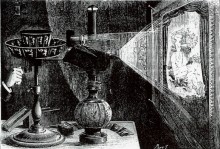Scientific American n°26 - 23 décembre 1882 - Page 406
Par Christelle Odoux le dimanche 5 octobre 1902, 12h00 - Presse - Lien permanent
The Projecting Praxinoscope
We have already made known to our readers an optical apparatus constructed by Mr. Reynaud, the “Praxinoscope”, which produces with remarkable clearness, by reflection, an animated illusion in the center of a prism of plane mirrors of the successive poses of a person in motion. We have also shown how, in the “Theater Praxinoscope”, such illusion is rendered completer by an ingenious arrangement which allows the animated object to appear on an appropriate ground or scene.
The recent remarkable experiments in instantaneous photography, which have permitted the different attitudes of man and animals being caught and fixed, seem to us to give a special interest to this sort of researches, and to consequently call attention to apparatus that allow of such attitudes being brought together after they have been fixed, so as to make a synthesis of them, so to speak, and to thus reproduce the action of life itself.
Such is the purpose of the new instrument that we here – with figure – the “Projecting Praxinoscope” – by means of which the images obtained are projected upon a screen so as to be visible to the entire audience.
By a modification of the lampascope, Mr. Reynaud obtains with the aid of an ordinary lamp, both a projection of the scene (through the objective seen at the side of the lantern and a projection of the animated object through an objective seen in front and a little above the lantern). To effect this, the poses or phases that form an object are drawn and colored on glass, and united into a band by connecting pieces of cloth. One of these flexible bands is placed in the flaring crown of the instrument, which latter contains apertures that correspond with the poses of the object.
To understand the direction taken by the luminous rays, we must imagine a condensing lens, which being near the flame of the lamp is not visible in the figure, and also a plane mirror inclined at an angle of 45°, which reflects the luminous fascicle and causes it to traverse the pictures behind the apertures in the crown. This luminous fascicle, which is again reflected by the facets of the prism of mirrors, flually enters the objective, and the latter transforms the central virtual image into a real and enlarged one on the screen.
By making the two parts of the apparatus converge slightly, the animated object is brought into the middle of the scene, where it then seems to undergo its motions as if endowed with life.
A moderate and regular motion is communicated to the instrument by means of a small winch affixed to the support. This apparatus furnishes with an ordinary moderator lamp pictures that are well lighted and that have a very curious effect. It will, then, allow of animated projections being obtained without the aid of a special luminous source, simply by the use of a common, every-day lamp
Voir la page du Praxinoscope à Projection
Voir la page Presse
